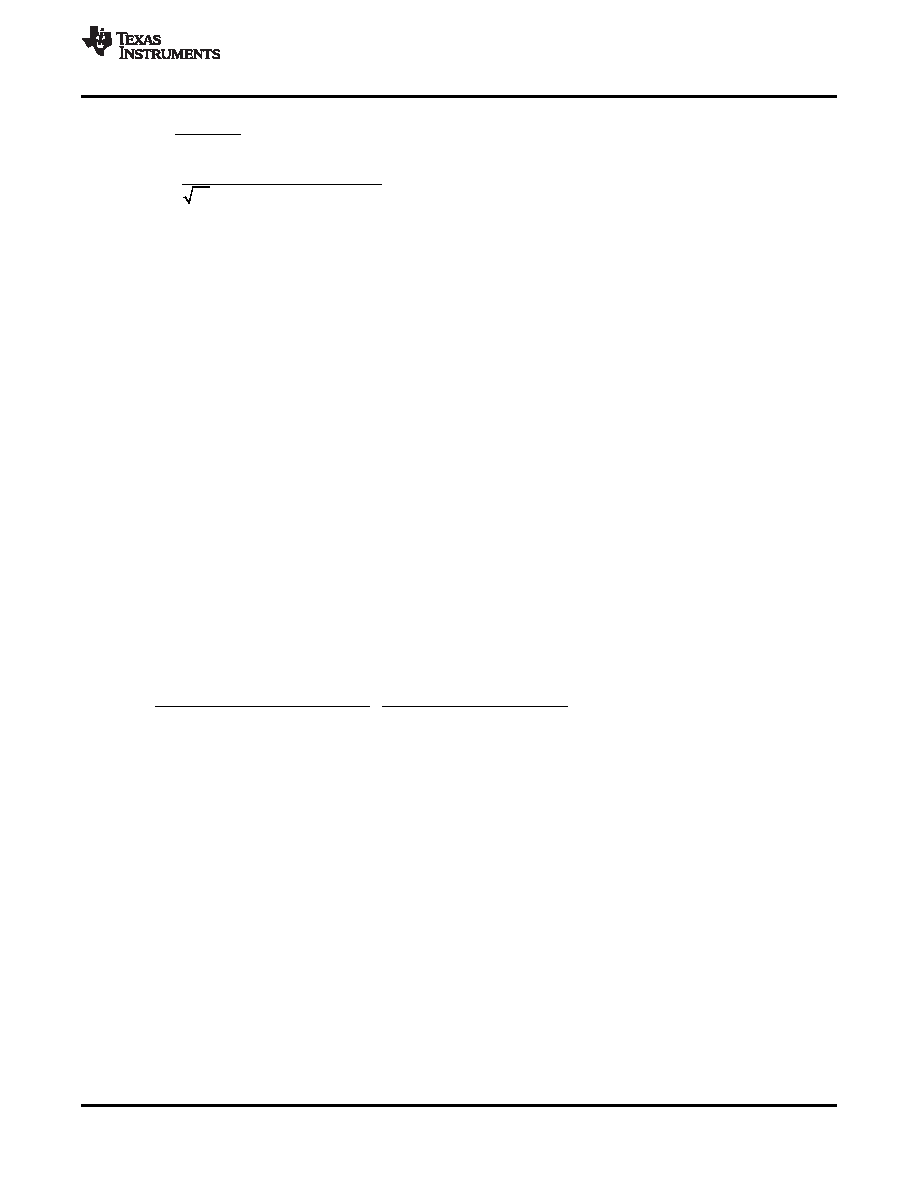- 您现在的位置:买卖IC网 > PDF目录98283 > TPS57040QDGQRQ1 (TEXAS INSTRUMENTS INC) SWITCHING REGULATOR, 2500 kHz SWITCHING FREQ-MAX, PDSO10 PDF资料下载
参数资料
| 型号: | TPS57040QDGQRQ1 |
| 厂商: | TEXAS INSTRUMENTS INC |
| 元件分类: | 稳压器 |
| 英文描述: | SWITCHING REGULATOR, 2500 kHz SWITCHING FREQ-MAX, PDSO10 |
| 封装: | GREEN, PLASTIC, MSOP-10 |
| 文件页数: | 27/51页 |
| 文件大小: | 1871K |
| 代理商: | TPS57040QDGQRQ1 |
第1页第2页第3页第4页第5页第6页第7页第8页第9页第10页第11页第12页第13页第14页第15页第16页第17页第18页第19页第20页第21页第22页第23页第24页第25页第26页当前第27页第28页第29页第30页第31页第32页第33页第34页第35页第36页第37页第38页第39页第40页第41页第42页第43页第44页第45页第46页第47页第48页第49页第50页第51页

ORIPPLE
ESR
RIPPLE
V
R
I
<
Vout
(Vin max
Vout)
Icorms =
12
Vin max
Lo
sw
-
(
)
2
-
Cj
sw
Vin + Vd
(Vin max
Vout)
Iout
Vd
Pd =
+
2
Vin max
SLVSAP4A
– DECEMBER 2010 – REVISED APRIL 2011
(35)
(36)
Catch Diode
The TPS57040-Q1 requires an external catch diode between the PH pin and GND. The selected diode must
have a reverse voltage rating equal to or greater than Vinmax. The peak current rating of the diode must be
greater than the maximum inductor current. The diode should also have a low forward voltage. Schottky diodes
are typically a good choice for the catch diode due to their low forward voltage. The lower the forward voltage of
the diode, the higher the efficiency of the regulator.
Typically, the higher the voltage and current ratings the diode has, the higher the forward voltage will be. Since
the design example has an input voltage up to 42V, a diode with a minimum of 42V reverse voltage will be
selected.
For the example design, the B160A Schottky diode is selected for its lower forward voltage and it comes in a
larger package size which has good thermal characteristics over small devices. The typical forward voltage of the
B160A is 0.50 volts.
The diode must also be selected with an appropriate power rating. The diode conducts the output current during
the off-time of the internal power switch. The off-time of the internal switch is a function of the maximum input
voltage, the output voltage, and the switching frequency. The output current during the off-time is multiplied by
the forward voltage of the diode which equals the conduction losses of the diode. At higher switch frequencies,
the ac losses of the diode need to be taken into account. The ac losses of the diode are due to the charging and
discharging of the junction capacitance and reverse recovery. Equation 37 is used to calculate the total power
dissipation, conduction losses plus ac losses, of the diode.
The B160A has a junction capacitance of 110pF. Using Equation 37, the selected diode will dissipate 0.290
Watts. This power dissipation, depending on mounting techniques, should produce a 5.9
°C temperature rise in
the diode when the input voltage is 42V and the load current is 0.5A.
If the power supply spends a significant amount of time at light load currents or in sleep mode consider using a
diode which has a low leakage current and slightly higher forward voltage drop.
(37)
Input Capacitor
The TPS57040-Q1 requires a high quality ceramic, type X5R or X7R, input decoupling capacitor of at least 3
μF
of effective capacitance and in some applications a bulk capacitance. The effective capacitance includes any dc
bias effects. The voltage rating of the input capacitor must be greater than the maximum input voltage. The
capacitor must also have a ripple current rating greater than the maximum input current ripple of the
TPS57040-Q1. The input ripple current can be calculated using Equation 38.
The value of a ceramic capacitor varies significantly over temperature and the amount of dc bias applied to the
capacitor. The capacitance variations due to temperature can be minimized by selecting a dielectric material that
is stable over temperature. X5R and X7R ceramic dielectrics are usually selected for power regulator capacitors
because they have a high capacitance to volume ratio and are fairly stable over temperature. The output
capacitor must also be selected with the dc bias taken into account. The capacitance value of a capacitor
decreases as the dc bias across a capacitor increases.
For this example design, a ceramic capacitor with at least a 60V voltage rating is required to support the
maximum input voltage. Common standard ceramic capacitor voltage ratings include 4V, 6.3V, 10V, 16V, 25V,
50V or 100V so a 100V capacitor should be selected. For this example, two 2.2
μF, 100V capacitors in parallel
have been selected. Table 1 shows a selection of high voltage capacitors. The input capacitance value
determines the input ripple voltage of the regulator. The input voltage ripple can be calculated using Equation 39.
Using the design example values, Ioutmax = 0.5 A, Cin = 4.4
μF, sw = 500 kHz, yields an input voltage ripple of
40.6 mV and a rms input ripple current of 0.247A.
Copyright
2010–2011, Texas Instruments Incorporated
33
相关PDF资料 |
PDF描述 |
|---|---|
| TPS57114QRTERQ1 | SWITCHING REGULATOR, 2000 kHz SWITCHING FREQ-MAX, PQCC16 |
| TPS60100PWP | 0.2 A SWITCHED CAPACITOR REGULATOR, 400 kHz SWITCHING FREQ-MAX, PDSO20 |
| TPS60101PWPG4 | SWITCHED CAPACITOR REGULATOR, 400 kHz SWITCHING FREQ-MAX, PDSO20 |
| TPS60101PWPRG4 | 0.1 A SWITCHED CAPACITOR REGULATOR, 400 kHz SWITCHING FREQ-MAX, PDSO20 |
| TPS60230RGTTG4 | 0.2 A SWITCHED CAPACITOR REGULATOR, 1250 kHz SWITCHING FREQ-MAX, PQCC16 |
相关代理商/技术参数 |
参数描述 |
|---|---|
| TPS57040QDRCRQ1 | 功能描述:直流/直流开关转换器 3.5-42Vin,0.5A Step Down SWIFT Cnvrtr RoHS:否 制造商:STMicroelectronics 最大输入电压:4.5 V 开关频率:1.5 MHz 输出电压:4.6 V 输出电流:250 mA 输出端数量:2 最大工作温度:+ 85 C 安装风格:SMD/SMT |
| TPS57060QDGQRQ1 | 功能描述:直流/直流开关转换器 3.5-60Vin,0.5A,2.5 MHz Step Down Cnvrtr RoHS:否 制造商:STMicroelectronics 最大输入电压:4.5 V 开关频率:1.5 MHz 输出电压:4.6 V 输出电流:250 mA 输出端数量:2 最大工作温度:+ 85 C 安装风格:SMD/SMT |
| TPS57060QDRCRQ1 | 功能描述:直流/直流开关转换器 3.5-60Vin,0.5A,2.5 MHz Step Down Cnvrtr RoHS:否 制造商:STMicroelectronics 最大输入电压:4.5 V 开关频率:1.5 MHz 输出电压:4.6 V 输出电流:250 mA 输出端数量:2 最大工作温度:+ 85 C 安装风格:SMD/SMT |
| TPS57112QRTERQ1 | 功能描述:直流/直流开关转换器 2.95-6Vin,2A,2MHz Sync St Down Cnvrtr RoHS:否 制造商:STMicroelectronics 最大输入电压:4.5 V 开关频率:1.5 MHz 输出电压:4.6 V 输出电流:250 mA 输出端数量:2 最大工作温度:+ 85 C 安装风格:SMD/SMT |
| TPS57114EVM | 制造商:Texas Instruments 功能描述:TPS57114EVM - Boxed Product (Development Kits) |
发布紧急采购,3分钟左右您将得到回复。